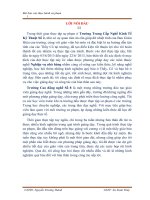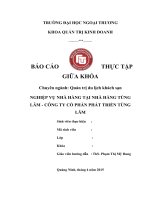nghiệp vụ nhà hàng PSU (Sake restaurant)
Bạn đang xem bản rút gọn của tài liệu. Xem và tải ngay bản đầy đủ của tài liệu tại đây (4.23 MB, 11 trang )
GROUP 4
CLASS: PSU HOS 361 AIS
SAKE TEPPANYAKI RESTAURANT
1. Type of Restaurant
Fine dining: Fine dining is a form of dining at a high-class restaurant. Contrary to
the bustling style, fine dining aims to experience a sophisticated culinary
experience, top-notch luxury with quality dishes. Diners often enjoy dishes with
fine wine and chat gently with each other in an extremely lavish space.
2. Restaurant’s name:
SAKE Teppanyaki
The group named the restaurant SAKE Teppanyaki for the reason: Sake is Japanese
rice wine. Teppanyaki is the type of service typical of the restaurant the group
wants to run. In particular, Sake is one of two indispensable side dishes when
enjoying Teppanyaki grilled dishes. In the summer, diners often eat Teppanyaki
dishes and sip cold Sake. Meanwhile, the reheated Sake is preferred in winter.
Therefore, enjoying Teppanyaki and drinking Sake is considered a feature in
Japanese culinary culture.
Therefore, combining Sake and Teppanyaki together to form a name that expresses
the restaurant's signature and one of the features in the way of enjoying Teppanyaki
dishes.
3. Concept
Sake Teppanyaki Restaurant is the result of a combination of Japanese cuisine and
culinary culture imported from the West. Blending with them is the unique flavor
of Sake. In 1945, the Misono restaurant chain proposed the idea of serving
European-style grilled dishes on Japanese cast iron pans. The idea became more
attractive and popular with foreigners rather than locals, and the Misono restaurant
chain became a popular tourist destination, and Teppanyaki's reputation began to
bloom from here. Gradually, Teppanyaki is also popularized in restaurants to
family meals all over Japan. In Japanese, "teppan" means "cast iron", "steel", and
"yaki" is a generic term for cooking methods in a pan such as frying, water-frying,
sautéing, and pan-frying. Cooking utensils with different ingredients. Although
simple, Teppanyaki has its own requirements to create something unique. The pan
used in Teppanyaki is always required to be a metal pan (most suitable cast iron or
steel), with a large thickness to keep heat and avoid burning the dish (ideal
thickness of 8cm). The grill is placed right in front of the diners, here we can see
with our own eyes the fresh ingredients are skillfully processed right on the
kitchen, the enjoyers are also required to add spices or choose the level of ripeness.
/ re. for the dishes of your choice and especially the visual "treat" from the chef
with knife dances, juggling ingredients, performances combined with cooking in
the hot heat. When it comes to baked goods in Japan, it is impossible not to
mention Sake. Sake is a traditional Japanese wine, so it is very suitable for
Japanese cuisine, such as sushi and sashimi. In addition, thanks to Umami's
character, this wine line can combine well with both Western dishes and Asian
treats. Sake is divided into 4 categories: Daiginjo, Junmai, Ginjo, Honjozo.
4. Location
Address: Layout L4-18 on 4th floor of Vincom Da Nang shopping mall (910A Ngo
Quyen, An Hai Bac, Son Tra, Da Nang)
Area: 65m2
Price: 250 - 300 million/month
Location: close to the elevator, opposite the escalator, opposite Gogi, right towards
the CGV cinema. 1 glass face facing the intersection Ngo Quyen - Han River
Bridge.
5. Restaurant design
For the teppanyaki area, for a partial viewing with pedestrians, the door is left open
to draw in customers with the ambiance and aroma of the dishes flying through the
“charming” doorway surrounded by everyone. It is not divided into main areas
such as the sushi area, teppan area, and kitchen area. The purpose of dividing the
area is to create a more friendly space for each area.
To offer the only meal or diner you'd like to experience the café also offers
showcases to display all the ingredients for sushi. Behind the cabinet is concealed
in wooden boards with wooden strips. There is an open shelf with a niche as the
frame for the shelf. At the address, there are 4 Japanese figurines illuminated from
the light on the top of the shelf to decorate.
From the sushi table to the dining area separated by a meter in height. The dining
area is like the exterior facade with a wooden ceiling. From the restaurant dining
area visible to the lobby from 7.5 meters open the glass. One of the other features
of the dining area is the roofing we use to minimize the height of the ceiling. A
dining area with a wooden top table and velvet-upholstered chairs provide you
with a comfortable dining experience.
The teppanyaki area creates a darker feel with soft light from the cove light to
highlight the wooden mural located behind the teppanyaki counter. The wall
features the use of different particle patterns to show different expression.
6. Produce & Service
The main ingredients used to make Sashimi are usually fresh seafood such as:
Salmon, Tuna, Mackerel, Sea Shrimp, Octopus, Squid, Snail ... There are also salt,
fresh lemon, white radish, Served with perilla, wasabi (green mustard) and
Japanese soy sauce standard.
In the Teppanyaki culture, there are delicious dishes from near and far because of
the delicious taste and crispy characteristic of the food served in the kitchen.
Sashimi cá hồi
Sashimi is raw seafood pieces that are usually cut into thin slices about 2.5cm
wide, 4cm long, and 0.5cm thick. The size of the sashimi may vary depending on
the type of ingredients and the chef's cut. Some types of seafood that Japanese
people often use to make sashimi are salmon, tuna, mackerel, saba fish, pufferfish,
squid, octopus, sea shrimp ... Sashimi is eaten with sauces such as soy sauce, soy
sauce, spices such as mustard, ginger, perilla leaves, and sliced white radish.
The Restaurant offers guests a choice of a complete meal at a fixed price. All the
sets include these following side dishes
-
Salad
-
Egg tofu with seaweed
-
Fried rice
-
Pickles
-
Miso soup
Teppanyaki will divide the dishes into many different subdivisions. One of the
famous Teppanyaki languages types is Teppanyaki European style. For grilled
dishes, the ingredients are cooked on a rustic pepper pan with few goals, the goal is
to preserve the deliciousness of the meat.
The ingredients are also rich in Western cuisine such as beef, tiger prawns,
lobsters, scallops ... The fibers or seafood are usually sliced quite thick, cooked
well on a pan to perfectly re-ripen, still succulent. but the meat is not chewy.
Teppanyaki's thick design allows for this perfect grill or steak.
Teppanyaki party would be bland without the pungent flavor of Sake and the salty,
sour flavors of sauces. Every famous sauce must go with each Japanese food. Like
Miso sauce with barbecue, Hanabusa sauce with stir-fried vegetables.
7. Menu
8. Grand Opening
- Advertising through local newspapers and magazines, distributing flyers about
restaurant opening events and attractive services, promotions/discounts will surely
impress a large number of people who approach, but who can be potential and
loyal customers of the restaurant and hotel in the future.
- Coupons: is a form of low-cost advertising, distributing coupons online and via
mobile applications.
- Souvenir gifts: giving guests gifts when guests come to the opening ceremony
(for example, key chains or gift bags).
- Advertise on specialized websites, social networking sites, fan page - place
banners, PR ads, SEO keywords on Google. Advertise on Facebook, create
advertising campaigns on Facebook for the opening ceremony of the restaurant.
Advertising on Facebook will help the restaurant reach a lot of potential customers
at a small cost ... these are good ways to help the restaurant's Grand Opening event
information reach and interact with a variety of classes, many potential customers.









